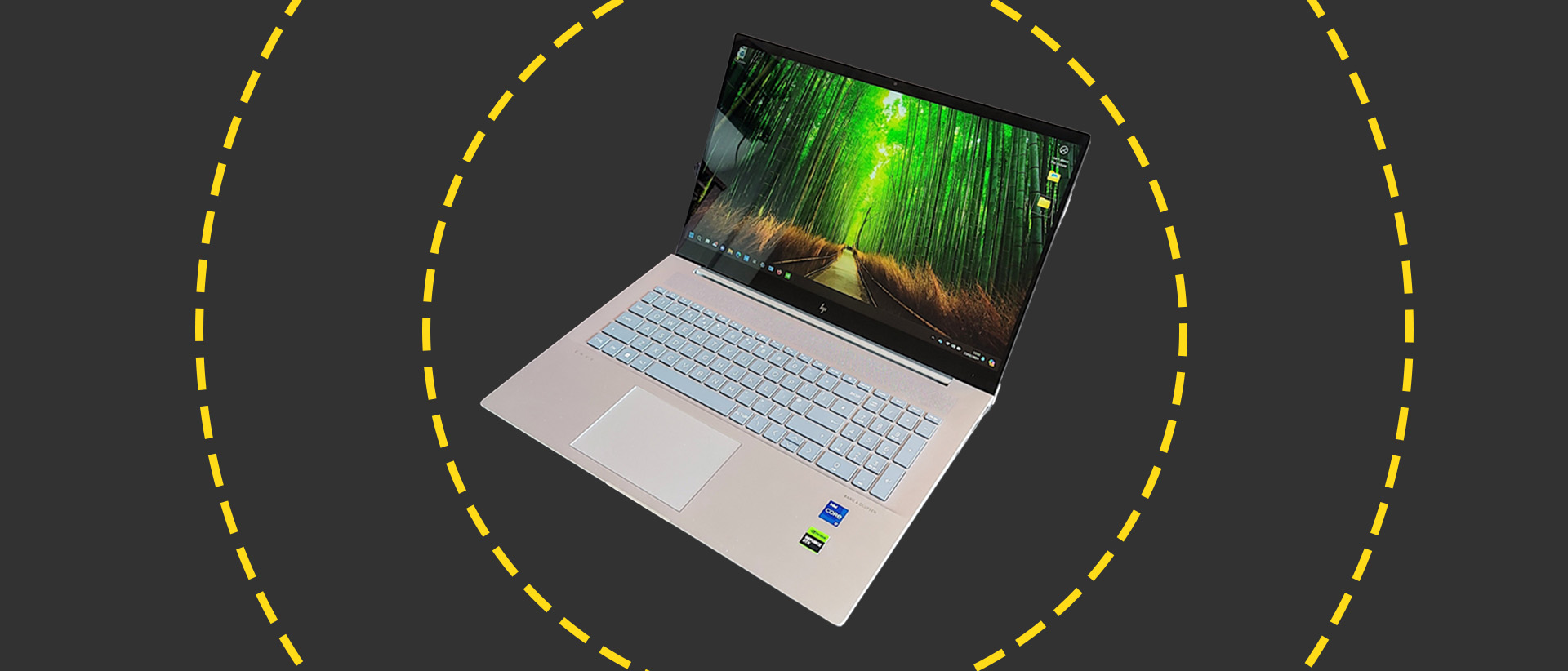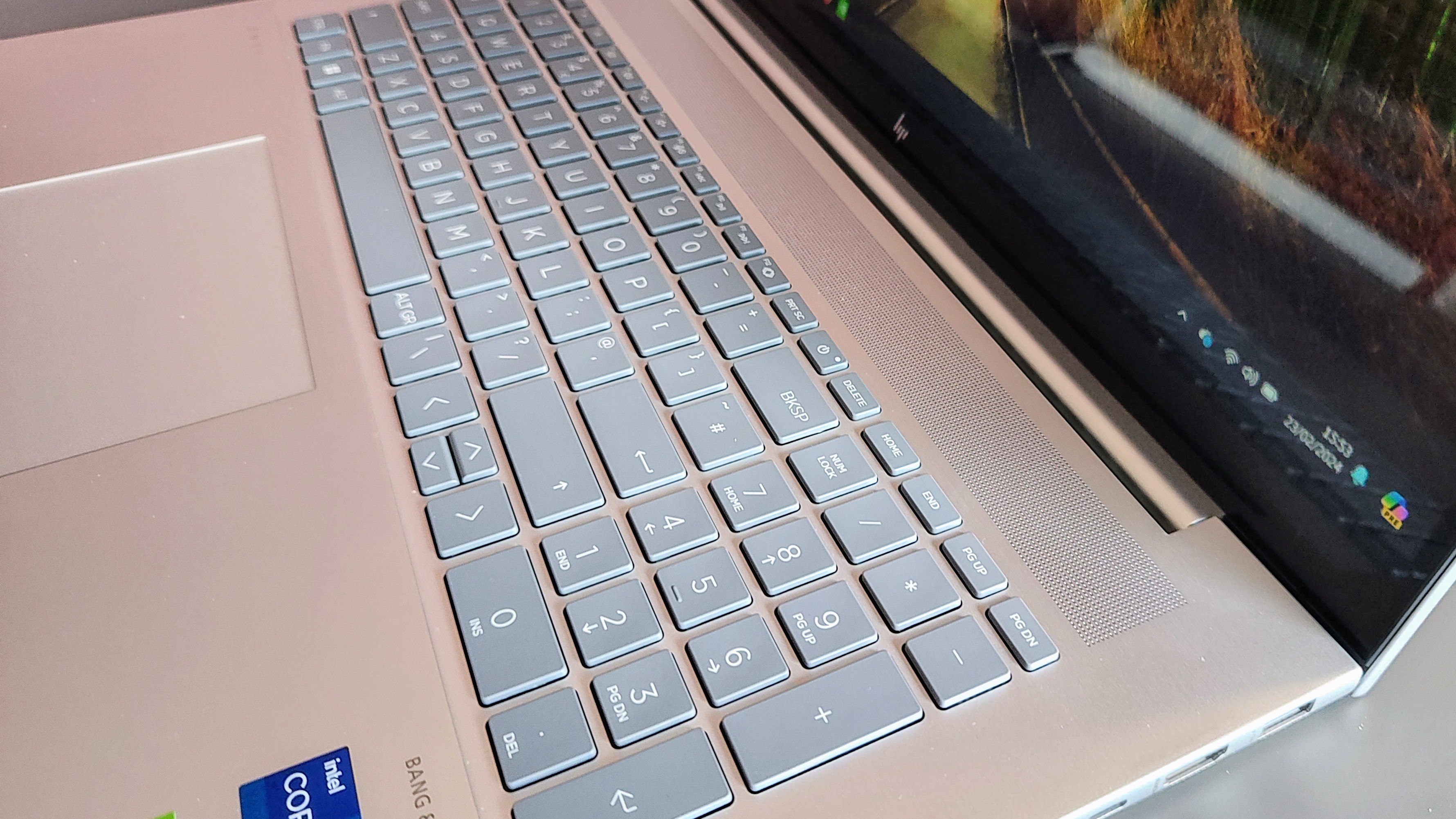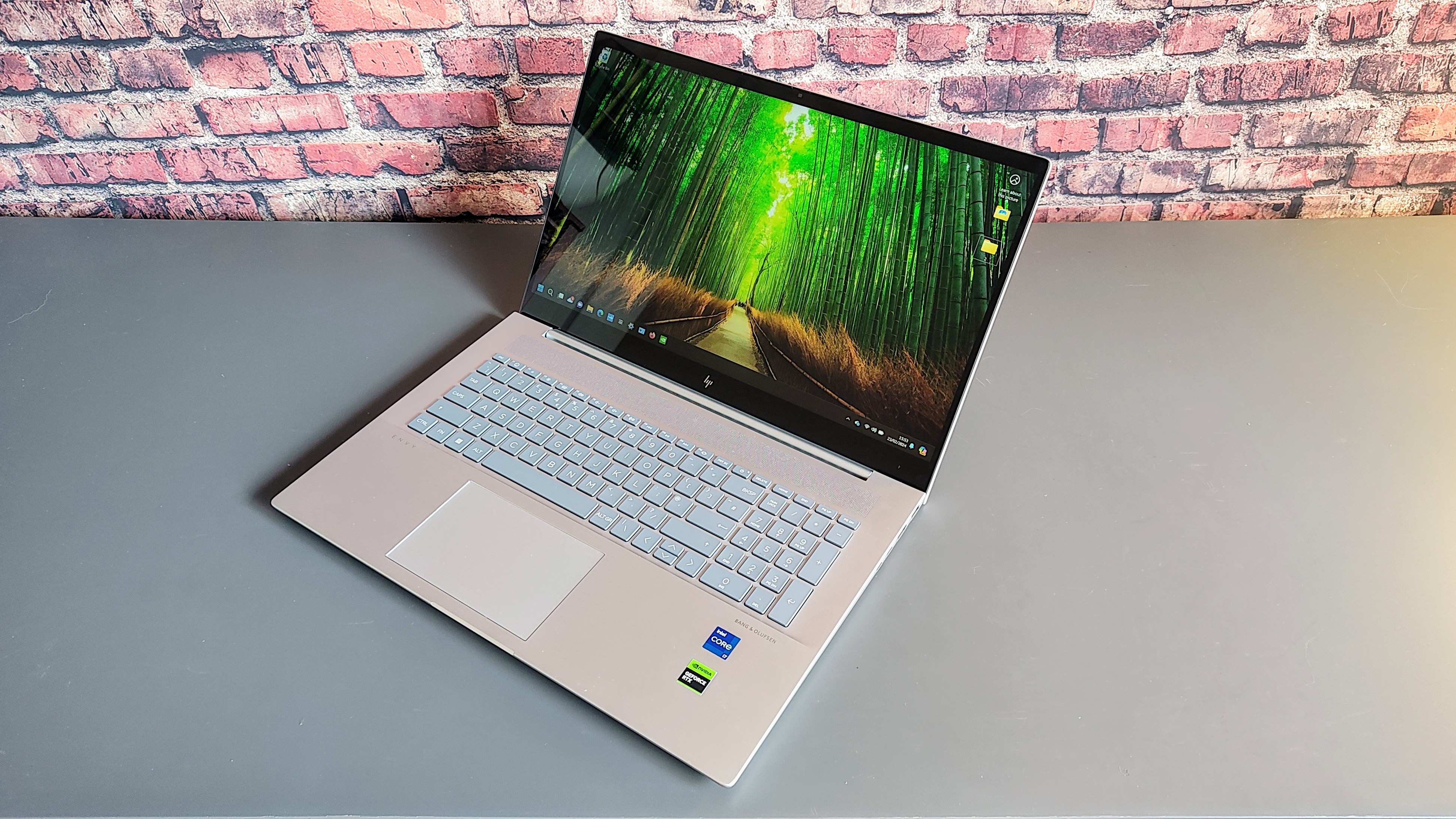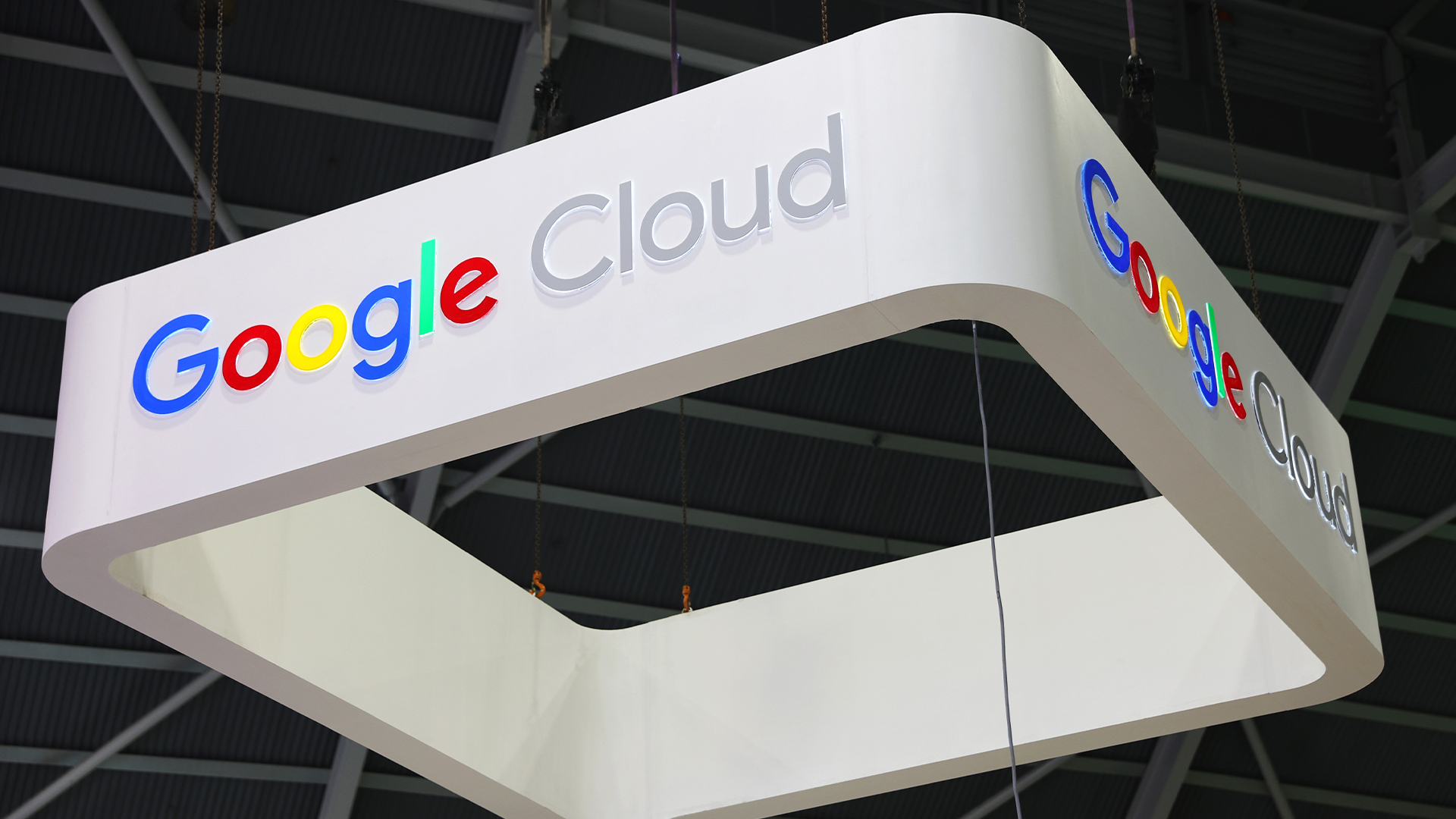HP Envy 17 review: An affordable big-screen workstation replacement
With the option of Nvidia graphics and a 4K display, the HP Envy 17 is a versatile yet affordable big-screen laptop

-
+
Good value
-
+
Thunderbolt 4 and 10Gbit/sec USB-A ports
-
+
Upgradeable RAM
-
+
Impressive B&O speaker system
-
-
RTX 3050 GPU only has a 40W TGP
-
-
No space for a second SSD
-
-
Middling performance
-
-
Poor battery life

Editor's note: Models like the HP Envy 17 have been largely overshadowed by the onslaught of AI PCs. HP has gone as far as to ditch various brand names in pursuit of clearer and cleaner model names that signify their AI prowess. But in reality, it also means models like the Envy gain more value for money as their price tags drop.
With a monitor on every desk and home office, there is less demand for big-screen laptops these days, but there are still times when you need a 17-inch display, like the one found on the HP Envy 17. Though the rise of 16in 16:10 laptops has reduced the need for anything bigger, a 17.3in screen still offers the best way to view spreadsheets, graphic design work, and or video editing.
HP Envy 17: Design
An all-metal chassis came as a surprise on the HP Envy 17, given its price. But most of the laptop, sans its plastic base, is made from recycled aluminum. Unfortunately, that does weigh it down at a rather heavy 2.4kg, but it is a very solid machine.
You can't really describe a 17.3in laptop as petite, but the HP Envy 17's dimensions (396 x 258.6 x 19.6mm) do a good job of making it comfortable to handle. Easy to slip into a backpack, effortless to carry.

The base and, more importantly, the lid, which, incidentally, only angles back to 140 degrees, are impressively stiff and resistant to all but the most brutal bending attempts. The matte silver finish and rounded profile make for a smart and discrete machine impervious to fingerprints.
HP has given the Envy 17 a decent array of ports with two Thunderbolt 4 ports on the right along with an HDMI 2.1 video output and a 10Gbit/sec USB-A port. On the left side, you'll find another two 10Gbit/sec USB-A ports, a 3.5mm audio jack, and a full-sized SD card reader.
Given that you have to use one of the Type-C ports to charge the Envy 17 it would have been better to have one on either side to attach the 90W charger but that is a minor niggle.
Wireless connectivity comes courtesy of an Intel AX211 card which supports both 6Ghz Wi-Fi 6E and Bluetooth 5.3 so you can take full advantage of the increased bandwidth of the former and reduced audio latency of the latter.
Sign up today and you will receive a free copy of our Future Focus 2025 report - the leading guidance on AI, cybersecurity and other IT challenges as per 700+ senior executives
HP Envy 17: Keyboard, touchpad, and webcam
There's much to like about the keyboard. First, the large, bold, white keycap graphics are very easy to read, and there's a two-stage white backlight. The numeric keypad comprises full-width keys, while the left and right cursor keys are similarly full-sized, but the up and down keys are half-height.

The keys themselves are made from soft-touch plastic and feel very pleasant to the touch. Combined with a crisp and precise 1.5mm of travel, it makes for an enjoyable typing experience. There is a little give in the keyboard deck in the middle, but it's nothing excessive and didn't get in the way of our work rate.
At 125 x 80mm, the touchpad is relatively small for such a large laptop, but the surface is perfectly smooth and reacts well to taps, swipes, and all the other Windows gestures you care to try. The click-action on the lower half of the pad is precise and sharp and not overly loud.
Sitting above the display is a 5MP webcam that can shoot video at up to 1080p 30fs and has a physical privacy shutter. It also supports Windows Hello facial recognition. The video feed from the camera is impressive, with surprisingly little noise and good color balance, even in low-light environments. The mic array does a good job, too, picking up what's being said with little echo or distortion and good background noise suppression.
HP Envy 17: Display
The Full HD IPS display fitted to our review machine was a pretty basic but competent affair: It's fully laminated and has a high-gloss finish. Maximum brightness is a reasonable 300cd/m2, while the contrast ratio is a good 1,361:1, helped by the low black luminescence of just 0.22cd/m2.
A 17.3in 1,920 x 1,080 screen will never be the last word in sharpness with a pixel density of 127dpi compared to the 4K model's 254dpi. Look closely at the FullHD screen and you can discern the pixel structure. That said, we didn't find it to be an issue in everyday use, the display being significantly crisper than on the FullHD 27in HP 27 All-in-One we tested in 2024.
Gamut volumes were solid if unspectacular, with 99.6% sRGB, 68.8% AdobeRGB, and 70.5% DCI-P3. There are no options to change the display color profile, which was hardly unexpected given the absence of wide gamuts, and the Delta E variance against the sRGB profile came back as 2.21.
That's a reasonable score and good enough for anything other than highly color-critical work, which is not a task the Envy 17 is really targeted at. Out of the box, the Envy 17's display recorded a gamma of 2.19 and a visual daylight temperature of 6542K, which is close to ideal.

Given the basic specification of the display, it doesn't have anything in the way of HDR capability. The only refresh rate options are 60.06Hz and 40.04Hz, so motion fidelity is as mediocre as expected, with evident smearing and ghosting in test animations. The Envy 17 may have a discrete Nvidia GPU, but it's no more a gaming machine than any other basic productivity laptop.
HP Envy 17: Specs and Performance
The first thing to note is that the Nvidia RTX 3050 GPU inside the Envy 17 is tuned down with a maximum TGP of 40W. It also has just 4GB of vRAM. That's a combination that does not make for high levels of performance.
In the ITPro 4K multi-media benchmark, the Envy 17 scored 251 points, which is better than many slim and light laptops we've tested, like the Asus Zenbook S13 and M2 MacBook Air, but seriously adrift of the Core i7-1360P powered Dell XPS 13 Plus which scored 352.
That's the problem with the Envy 17's U-series i7 chip; it's designed for efficiency rather than power, with only 2 of its 10 cores being performance rather than efficiency compared to 4 of the 12 in the i7-1360P. Both processors have the same 5Ghz maximum turbo frequency.
The industry-standard PCMark 10 Office and 3DMark Time Spy benchmark produced scores of 5,174 and 3,815 compared to 5,698 and 1,992 from the XPS 13 Plus. That suggests that the Envy 17 should be able to show the Dell a clean pair of heels when it comes to graphics jobs. And so it proved.
RELATED WHITEPAPER

The Envy 17 has a 55Wh battery, small for a laptop with a discrete GPU. In our standard video run-down test using the VLC video player the Envy 17 lasted just seven hours and 18 minutes, which is seriously short of HP's claim of "up to 11 hours 45 minutes".
We never once managed to get through a full day's work without plugging the Envy 17 in, which was a bit of a bind. If the Envy 17 were a tightly packaged superlight machine, we'd be more forgiving of this failing, but there is certainly enough room for a physically larger battery inside the chassis.
HP Envy 17: Is it worth it?
Currently, the Envy 17 can be had for as little as $799.99, which is a significant drop from the $930 it was offered at last year. Naturally, there will be better value for money buying in bulk, but it can't be ignored that this is a surprisingly good deal.
The mass release of AI PCs and the changes branding changes across HP may have cast a shadow over models like the Envy but we believe it is still worth considering.
It may have that throttled Nvidia GPU and U-series i7 processor, but it still can chew through even the most demanding graphics tasks faster than any machine relying on an integrated GPU. The relatively poor battery life is a serious mark against it, though.
HP Envy 17 Specification
Display | 17.3-inch 1,920 x 1,080 IPS, 16:9 aspect ratio, 60Hz refresh rate, 300cd/m2 brightness |
Processor | Intel Core i7-1355U |
GPU | Nvidia RTX 3050, 4GB vRAM, 40W TGP |
RAM | 16GB DDR4 3200MHz |
Ports | Thunderbolt 4 x 2, USB-A 3.2 Gen 2 x 3, HDMI 2.1 x 1 |
3.5mm audio jack | Yes |
Camera | 1080p webcam with privacy shutter |
Storage | 512 PCIe 4 SSD |
Connectivity | Wi-Fi 6E (802.11ax), Bluetooth v5.3 |
Weight | 2.49Kg |
Dimensions | 396 x 258.6 x 19.6mm |
Battery Capacity | 55Wh |
Operating System | Windows 11 Home |
Over the years, Alun has written freelance for several online publications on subjects ranging from mobile phones to digital audio equipment and PCs and from electric cars to industrial heritage. Before becoming a technology writer, he worked at Sony Music for 15 years. Quite what either occupation has to do with the degree in Early Medieval History he read at the University of Leeds is a bit of a grey area. A native of Scotland but an adopted Mancunian, Alun divides his time between writing, listening to live music, dreaming of the glens and dealing with an unhinged Norwegian Elkhound. For ITPro, Alun reviews laptops and PCs from brands such as Acer, Asus, Lenovo, Dell and HP.
-
 OpenAI's 'Skills in Codex' service aims to supercharge agent efficiency for developers
OpenAI's 'Skills in Codex' service aims to supercharge agent efficiency for developersNews The Skills in Codex service will provide users with a package of handy instructions and scripts to tweak and fine-tune agents for specific tasks.
By Ross Kelly Published
-
 Cloud infrastructure spending hit $102.6 billion in Q3 2025 – and AWS marked its strongest performance in three years
Cloud infrastructure spending hit $102.6 billion in Q3 2025 – and AWS marked its strongest performance in three yearsNews Hyperscalers are increasingly offering platform-level capabilities that support multi-model deployment and the reliable operation of AI agents
By Emma Woollacott Published
-
 Google Cloud teases revamped partner program ahead of 2026
Google Cloud teases revamped partner program ahead of 2026News The cloud giant’s new-look partner ecosystem shifts focus from activity tracking to measurable customer outcomes
By Daniel Todd Published
